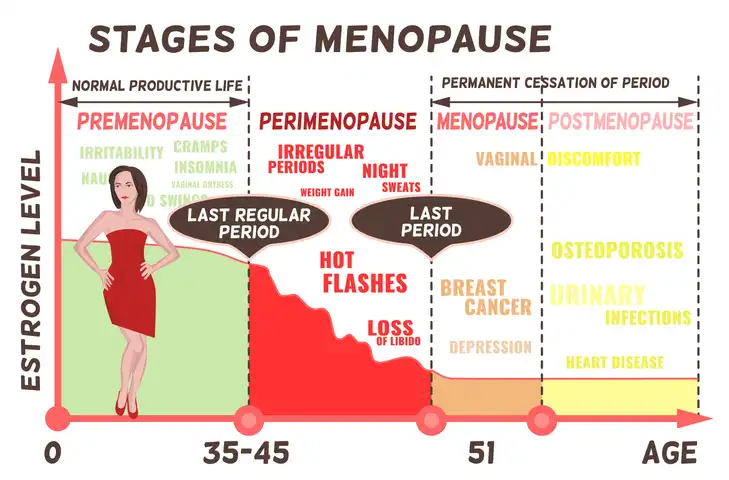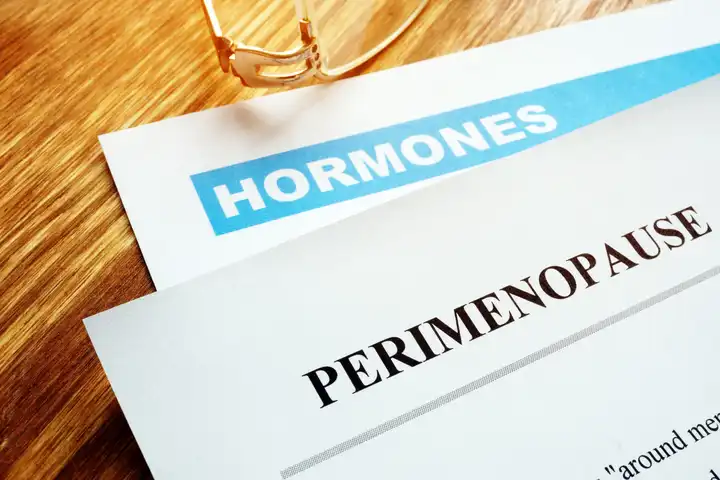The journey through menopause can be confusing, especially when it comes to understanding the various stages that lead up to it. Two terms that often cause confusion are Premenopause vs Perimenopause. While they are related, they represent different phases in the transition from reproductive years to postmenopausal life. Understanding Premenopause vs Perimenopause is crucial for managing symptoms, seeking appropriate treatment, and preparing for what’s ahead.

What is Premenopause vs Perimenopause?
Ever found yourself wondering, “Am I in perimenopause or premenopause?” Or maybe you’ve heard both terms tossed around and thought, “Aren’t they the same thing?” If you’re feeling confused, you’re not alone—and understanding the difference can actually change how you manage your health and hormones.
Let’s clear things up with a quick breakdown.
Premenopause is a bit of a sneaky term. It refers to all the years of your reproductive life before menopause—basically, from your first period until things start to noticeably shift. In this phase, your hormones are still doing their usual monthly dance, even if you’re not paying much attention to them.
Perimenopause, on the other hand, is the transitional phase leading up to menopause. This is when things start to get interesting—your hormone levels begin to fluctuate, and you might notice changes in your cycle, mood, sleep, and more. It usually starts in your 40s (sometimes earlier) and can last several years.
So, here’s the answer you’ve been looking for:
👉 Premenopause is the calm before the storm. Perimenopause is the storm itself.
Keep reading to understand what’s really happening in your body—and how to navigate this transition with clarity and confidence.
The Perimenopause Timeline: What Happens During This Phase?
Now that we’ve cleared up the difference between premenopause and perimenopause, let’s take a closer look at what perimenopause really involves—and why it can feel so different for every woman.
Perimenopause is the body’s way of gradually winding down its reproductive function. It’s the phase where your hormone levels—especially estrogen and progesterone—start to shift and become less predictable. These changes don’t usually happen all at once, which is why many women are caught off guard.
According to the Cleveland Clinic, perimenopause can begin 8 to 10 years before menopause, typically starting in your 40s (though some women notice changes in their late 30s). At first, you might not realize anything is different. Maybe your cycle shortens a bit, or your PMS feels more intense. Over time, though, symptoms tend to become more noticeable.
Some of the most common signs of perimenopause include:
- Irregular periods
- Hot flashes or night sweats
- Mood swings or irritability
- Sleep disturbances
- Brain fog or difficulty concentrating
While premenopause is the stage where everything is still running smoothly hormonally, perimenopause is when the shift begins. And for some women, it’s a slow and subtle change. For others, it feels like their body flipped a switch overnight.
The final stage of perimenopause—often called the menopausal transition—is when estrogen levels drop sharply, and your periods may become very infrequent or stop completely. This signals that menopause is right around the corner.
Understanding this timeline can help you feel more in control and less overwhelmed. And if symptoms are affecting your quality of life, don’t wait—this is exactly the time to reach out to a healthcare provider. Getting support during perimenopause can make a world of difference.

Symptoms of Perimenopause vs Premenopause: A Closer Look
As we’ve just explored in the perimenopause timeline, hormonal shifts don’t happen overnight—but the effects can build up fast. And understanding the symptoms is key to feeling prepared rather than blindsided.
In premenopause, most women don’t notice any major changes. Periods are still regular, hormone levels are fairly stable, and symptoms like hot flashes or mood swings are generally absent. Some subtle hormonal fluctuations may begin, but they rarely cause discomfort or disrupt daily life at this stage.
But once you enter perimenopause, things begin to shift—and the experience can be surprisingly intense.
Hormone levels, especially estrogen, start rising and falling in unpredictable patterns, triggering a variety of physical and emotional symptoms. And here’s something many people don’t realize:
👉 Research shows there are more than 34 recognized symptoms of perimenopause, and some experts suggest that number may be closer to 50 or more.
That’s why two women going through perimenopause might have completely different experiences—one might struggle with insomnia and anxiety, while another deals with migraines and weight gain.
Common Symptoms of Perimenopause Include:
- Irregular or heavier/lighter periods
- Hot flashes and night sweats
- Mood swings, irritability, or anxiety
- Difficulty sleeping or full-blown insomnia
- Weight gain, especially around the abdomen
- Decreased libido or changes in sexual function
- Vaginal dryness or discomfort
- Brain fog or forgetfulness
- Headaches or migraines
- Dry skin or thinning hair
- Increased urinary frequency or urgency
These symptoms tend to become more noticeable in the later stages of perimenopause, when hormone fluctuations are more extreme. For many women, this phase can feel disruptive, confusing, and at times overwhelming.
That’s why recognizing and understanding the difference between premenopause vs perimenopause is so powerful—it helps you know what to expect, when to seek help, and how to better support your body during the transition.menopause.
When to See a Doctor About Perimenopause Symptoms
It’s important to track your symptoms, especially as they begin to impact your daily life. While most symptoms of perimenopause and menopause are manageable, some signs might indicate a more serious condition, and you should seek medical advice if:
Recognizing symptoms during Premenopause vs Perimenopause is critical for early intervention and management.
Addressing Premenopause vs Perimenopause through treatment options can greatly improve your quality of life during these transitions.
- You experience irregular bleeding, spotting after your period, or bleeding after intercourse.
- Periods last longer than usual or are extremely heavy.
- You experience sharp pelvic pain or unexplained changes in your body.
- Hot flashes, mood swings, or sleep disturbances become debilitating.
Discuss the benefits of HRT in the context of Premenopause vs Perimenopause to better understand its potential effects.
Consulting a doctor about Premenopause vs Perimenopause can provide clarity and tailored advice for individual health needs.
Non-hormonal treatments are also available to address symptoms arising from Premenopause vs Perimenopause.
These symptoms could be linked to other conditions, such as fibroids or endometriosis, which are treatable. Always consult your doctor to rule out other health issues.

Treatment Options for Perimenopause vs Premenopause
Hormone Replacement Therapy (HRT):
One of the most common treatments for perimenopausal symptoms is hormone replacement therapy (HRT), which works to normalize estrogen levels. HRT can help reduce hot flashes, night sweats, vaginal dryness, and even prevent osteoporosis. Available in various forms (oral pills, patches, creams), HRT can provide relief, but it’s important to discuss its risks and benefits with your healthcare provider.
Non-Hormonal Medications:
Understanding Premenopause vs Perimenopause can empower women to embrace this transition.
Making lifestyle adjustments can significantly benefit women during Premenopause vs Perimenopause.
There are also non-hormonal treatments available, including:
Exploring treatment options for Premenopause vs Perimenopause can empower you to choose the best path for your health.
Exploring how Premenopause vs Perimenopause affect each woman uniquely can provide insight into personal health journeys.
- Antidepressants (SSRIs or SNRIs) for mood swings and depression.
- Gabapentin for hot flashes.
- Vaginal creams to relieve dryness and discomfort during intercourse.
Many women often ask about the differences in their experiences during Premenopause vs Perimenopause.
It’s important to understand that Premenopause vs Perimenopause can vary greatly in terms of symptoms and duration.
As the journey progresses from Premenopause vs Perimenopause, support systems can play a crucial role.
Monitoring changes during Premenopause vs Perimenopause can help in making informed health choices.
It’s key to discuss Premenopause vs Perimenopause openly with healthcare providers to navigate these changes effectively.
Understanding your personal journey through Premenopause vs Perimenopause helps in managing expectations.
Recognizing the signs of Premenopause vs Perimenopause is essential for proactive health management.
Home Remedies and Lifestyle Adjustments
In conclusion, Premenopause vs Perimenopause requires mindfulness and awareness to navigate effectively.
In addition to medical treatments, there are several lifestyle changes and home remedies that can help manage symptoms:
Utilizing home remedies during Premenopause vs Perimenopause may provide additional relief and comfort.
- Exercise Regularly: Exercise helps combat weight gain, improves mood, and reduces hot flashes. Aim for at least 30 minutes of moderate exercise most days of the week.
- Maintain a Healthy Diet: Eat a balanced diet rich in fruits, vegetables, and whole grains to support hormone balance. Avoid excessive caffeine, alcohol, and spicy foods that can trigger hot flashes.
- Prioritize Sleep: Establish a relaxing nighttime routine. Avoid caffeine and large meals before bed, and try a warm bath or gentle yoga to promote restful sleep.
- Stay Hydrated: Drinking plenty of water helps with skin hydration and reduces bloating.
- Stress Management: Stress can exacerbate symptoms, so incorporate relaxation techniques such as meditation or deep breathing exercises.
Embracing the journey of Premenopause vs Perimenopause can lead to a more fulfilling life experience.
Outlook: Embracing the Transition
While the stages of Perimenopause and Premenopause can feel overwhelming, it’s important to remember that they are natural transitions. Many women successfully navigate these years with the help of medical treatments, lifestyle changes, and support networks.
If you’re experiencing symptoms of perimenopause, reach out to a healthcare professional. By discussing your concerns and exploring treatment options, you can manage this phase of life with more confidence and comfort.
By understanding Premenopause vs Perimenopause, you can take charge of your health during this transition.
For additional tips and insights on managing perimenopausal symptoms, visit our comprehensive guide on Understanding Perimenopause Symptoms. Remember, you don’t have to go through this alone – knowledge is power, and the right treatment can help you navigate this life stage with ease
Knowing the differences in Premenopause vs Perimenopause can also help in addressing common concerns.
It’s essential to recognize that Premenopause vs Perimenopause affects each woman differently.
Conclusion
Understanding the implications of Premenopause vs Perimenopause can guide decisions about family planning.
Exploring treatment options for Premenopause vs Perimenopause is crucial for effective symptom management.
Understanding the distinction between Perimenopause vs Premenopause is crucial for women as they approach this transitional phase. By knowing the symptoms, when to seek medical advice, and available treatments, you can take proactive steps to ensure a smoother transition. Whether it’s lifestyle adjustments or medication, there are many ways to manage the changes your body is going through. Stay informed, seek support, and embrace this new chapter with confidence.
As you navigate through Premenopause vs Perimenopause, consider tracking your symptoms for better insights.
Understanding when to seek help regarding Premenopause vs Perimenopause is vital for your well-being.
Frequently Asked Questions (FAQ)
Discussing the risks associated with Premenopause vs Perimenopause can help in making informed health choices.
1. What is the difference between Perimenopause vs Premenopause?
Premenopause refers to the period in a woman’s life before any noticeable symptoms of menopause begin, with regular menstrual cycles and no significant hormonal changes. Perimenopause, on the other hand, is the transitional phase before menopause where women may begin experiencing symptoms like irregular periods, hot flashes, and mood swings due to fluctuating hormone levels.
2. At what age does Perimenopause start?
Perimenopause typically begins in your 40s but can start earlier, sometimes even in your late 30s. It lasts for several years and ends when you reach menopause, which is officially defined as 12 months without a period.
3. Can I get pregnant during Perimenopause?
Yes, it is still possible to get pregnant during Perimenopause since you may still be ovulating, although less frequently. It’s important to use contraception if you don’t want to conceive during this phase.
4. What are the common symptoms of Perimenopause?
Common symptoms of Perimenopause include irregular periods, hot flashes, night sweats, mood swings, sleep disturbances, weight gain, vaginal dryness, and decreased libido. According to Mayo Clinic, these symptoms are caused by fluctuating estrogen levels in your body.”
Staying informed about Premenopause vs Perimenopause can aid in making lifestyle choices that promote better health.
As you navigate Premenopause vs Perimenopause, remember that support from healthcare professionals can be invaluable.
5. Is Premenopause the same as being in your reproductive years?
Yes, Premenopause refers to the period when you are still in your reproductive years and experiencing regular menstrual cycles without symptoms of menopause. You may notice some hormonal fluctuations, but they don’t cause significant changes in your body.
6. How long does Perimenopause last?
The duration of Perimenopause can vary. For some women, it may last as little as a few months, while for others, it can last 4-10 years. The symptoms often intensify as you approach menopause.
7. Can I manage Perimenopause symptoms naturally?
Yes, many women manage Perimenopause symptoms with lifestyle changes such as regular exercise, a balanced diet, stress management techniques, and adequate sleep. Herbal supplements like black cohosh and evening primrose oil are also commonly used, though it’s important to consult a doctor before trying these remedies.
Understanding Premenopause vs Perimenopause is the first step toward effectively managing your health during this transformative time.
8. When should I consult a doctor about my symptoms?
If your symptoms of Perimenopause (such as hot flashes, mood swings, or irregular periods) become severe or interfere with your daily life, it’s a good idea to consult with your healthcare provider. Additionally, if you experience unusual bleeding, pain, or other significant changes, you should seek medical advice.
Knowledge of Premenopause vs Perimenopause is essential when discussing symptoms and treatment options with your doctor.
Being aware of Premenopause vs Perimenopause allows you to seek help earlier, reducing discomfort and risks.
During Perimenopause vs Premenopause, proactive health management can significantly improve your quality of life.
Discussing the implications of Perimenopause vs Premenopause with your doctor can clarify what to expect as you transition.
9. Can Perimenopause lead to other health issues?
Yes, during Perimenopause, hormonal changes can lead to a variety of health concerns such as osteoporosis (due to decreased estrogen), heart disease risk, and changes in cholesterol levels. Regular check-ups and monitoring of health markers are important during this time.
Understanding how Perimenopause vs Premenopause interacts with your overall health can guide better lifestyle decisions.
10. What treatments are available for Perimenopause?
Treatment options for Perimenopause may include hormone replacement therapy (HRT), antidepressants for mood swings, vaginal creams for dryness, and lifestyle changes such as exercise and stress reduction techniques. Your doctor can help you decide on the best treatment based on your symptoms and health history.
Consulting health resources on Premenopause vs Perimenopause ensures you remain well-informed about your body’s changes.
Recognizing the differences of Perimenopause vs Premenopause can help women navigate this life stage more effectively.







